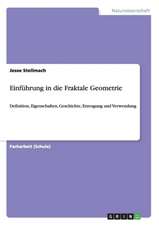5000 Years of Geometry: Mathematics in History and Culture
Autor Christoph J. Scriba, Peter Schreiber Traducere de Jana Schreiberen Limba Engleză Hardback – 5 mai 2015
Geometry originated in the ancient cultures along the Indus and Nile Rivers and in Mesopotamia, experiencing its first “Golden Age” in Ancient Greece. Inspired by the Greek mathematics, a new germ of geometry blossomed in the Islamic civilizations. Through the Oriental influence on Spain, this knowledge later spread to Western Europe. Here, as part of the medieval Quadrivium, the understanding of geometry was deepened, leading to a revival during the Renaissance. Together with parallel achievements in India, China, Japan and the ancient American cultures, the European approaches formed the ideas and branches of geometry we know in the modern age: coordinate methods, analytical geometry, descriptive and projective geometry in the 17th an 18th centuries, axiom systems, geometry as a theory with multiple structures and geometry in computer sciences in the 19th and 20th centuries.
Each chapter of the book starts with a table of key historical and cultural dates and ends with a summary of essential contents of geometr
y in the respective era. Compelling examples invite the reader to further explore the problems of geometry in ancient and modern times. The book will appeal to mathematicians interested in Geometry and to all readers with an interest in cultural history.
From letters to the authors for the German language edition
I hope it gets a translation, as there is no comparable work.
Prof. J. Grattan-Guinness (Middlesex University London)
"Five Thousand Years of Geometry" - I think it is the most handsome book I have ever seen from Springer and the inclusion of so many color plates really improves its appearance dramatically!
Prof. J.W. Dauben (City University of New York)
An excellent book in every respect. The authors have successfully combined the history of geometry with the general development of culture and history. …
The graphic design is also excellent.
Prof. Z. Nádenik (Czech Technical University in Prague)
Preț: 1507.94 lei
Preț vechi: 1838.95 lei
-18% Nou
Puncte Express: 2262
Preț estimativ în valută:
288.64€ • 313.63$ • 242.61£
288.64€ • 313.63$ • 242.61£
Carte tipărită la comandă
Livrare economică 21 aprilie-05 mai
Preluare comenzi: 021 569.72.76
Specificații
ISBN-13: 9783034808972
ISBN-10: 3034808976
Pagini: 600
Ilustrații: XII, 626 p. 313 illus., 156 illus. in color.
Dimensiuni: 155 x 235 x 32 mm
Greutate: 11.92 kg
Ediția:2015
Editura: Springer
Colecția Birkhäuser
Locul publicării:Basel, Switzerland
ISBN-10: 3034808976
Pagini: 600
Ilustrații: XII, 626 p. 313 illus., 156 illus. in color.
Dimensiuni: 155 x 235 x 32 mm
Greutate: 11.92 kg
Ediția:2015
Editura: Springer
Colecția Birkhäuser
Locul publicării:Basel, Switzerland
Public țintă
Lower undergraduateCuprins
Introduction.- 1.The beginnings of geometrical representations and calculations.- 2.Geometry in the Greek-Hellenistic era and late Antiquity.- 3.Oriental and old American geometry.- 4.Geometry in the European Middle Ages.- 5.New impulses for geometry during the Renaissance.- 6.The development of geometry in the 17th/18th centuries.- 7.New paths of geometry in the 19th century.- 8.Geometry in the 20th century.- Appendix: Selection of original texts.- References.- List of Figures.- Index of Names.- Index of Subjects.
Recenzii
“The book is highly readable and richly illustrated.This book contains a wealth of geometric and historic information. It alsocontains a list of references, a list of figures together with theirprovenances, an index of names, and an index of subjects. … the book is a wellresearched history of geometry reference manual and would make a welcomeaddition to any mathematician’s bookshelf.” (James J. Tattersall, MathematicalReviews, December, 2015)
“It is a very good book indeed, and an important and valuable addition to the literature on the subject. … the book is interesting and well-written, and filled with excellent figures … . The topic coverage throughout is excellent, and readers should learn a great deal from this book. … this is an important and valuable book. If you like either geometry or the history of mathematics, take a look at it.” (Mark Hunacek, MAA Reviews, June, 2015)
“It is a very good book indeed, and an important and valuable addition to the literature on the subject. … the book is interesting and well-written, and filled with excellent figures … . The topic coverage throughout is excellent, and readers should learn a great deal from this book. … this is an important and valuable book. If you like either geometry or the history of mathematics, take a look at it.” (Mark Hunacek, MAA Reviews, June, 2015)
Textul de pe ultima copertă
The present volume provides a fascinating overview of geometrical ideas and perceptions from the earliest cultures to the mathematical and artistic concepts of the 20th century. It is the English translation of the 3rd edition of the well-received German book “5000 Jahre Geometrie,” in which geometry is presented as a chain of developments in cultural history and their interaction with architecture, the visual arts, philosophy, science, and engineering.
Geometry originated in the ancient cultures along the Indus and Nile Rivers and in Mesopotamia, experiencing its first “Golden Age” in Ancient Greece. Inspired by the Greek mathematics, a new germ of geometry blossomed in the Islamic civilizations. Through the Oriental influence on Spain, this knowledge later spread to Western Europe. Here, as part of the medieval Quadrivium, the understanding of geometry was deepened, leading to a revival during the Renaissance. Together with parallel achievements in India, China, Japan and the ancient American cultures, the European approaches formed the ideas and branches of geometry we know in the modern age: coordinate methods, analytical geometry, descriptive and projective geometry in the 17th an 18th centuries, axiom systems, geometry as a theory with multiple structures, and geometry in computer sciences in the 19th and 20th centuries.
Each chapter of the book starts with a table of key historical and cultural dates and ends with a summary of essential contents of geome
try in the respective era. Compelling examples invite the reader to further explore the problems of geometry in ancient and modern times. The book will appeal to mathematicians interested in Geometry, and to all readers with an interest in cultural history.
From letters to the authors for the German language edition
I hope it gets a translation, as there is no comparable work.
Prof. J. Grattan-Guinness (Middlesex University London)
"Five Thousand Years of Geometry" - I think it is the most handsome book I have ever seen from Springer, and the inclusion of so many color plates really improves its appearance dramatically!
Prof. J.W. Dauben (City University of New York)
An excellent book in every respect. The authors have successfully combined the history of geometry with the general development of culture and history. …
The graphic design is also excellent.
Prof. Z. Nádenik (Czech Technical University in Prague)
Geometry originated in the ancient cultures along the Indus and Nile Rivers and in Mesopotamia, experiencing its first “Golden Age” in Ancient Greece. Inspired by the Greek mathematics, a new germ of geometry blossomed in the Islamic civilizations. Through the Oriental influence on Spain, this knowledge later spread to Western Europe. Here, as part of the medieval Quadrivium, the understanding of geometry was deepened, leading to a revival during the Renaissance. Together with parallel achievements in India, China, Japan and the ancient American cultures, the European approaches formed the ideas and branches of geometry we know in the modern age: coordinate methods, analytical geometry, descriptive and projective geometry in the 17th an 18th centuries, axiom systems, geometry as a theory with multiple structures, and geometry in computer sciences in the 19th and 20th centuries.
Each chapter of the book starts with a table of key historical and cultural dates and ends with a summary of essential contents of geome
try in the respective era. Compelling examples invite the reader to further explore the problems of geometry in ancient and modern times. The book will appeal to mathematicians interested in Geometry, and to all readers with an interest in cultural history.
From letters to the authors for the German language edition
I hope it gets a translation, as there is no comparable work.
Prof. J. Grattan-Guinness (Middlesex University London)
"Five Thousand Years of Geometry" - I think it is the most handsome book I have ever seen from Springer, and the inclusion of so many color plates really improves its appearance dramatically!
Prof. J.W. Dauben (City University of New York)
An excellent book in every respect. The authors have successfully combined the history of geometry with the general development of culture and history. …
The graphic design is also excellent.
Prof. Z. Nádenik (Czech Technical University in Prague)
Caracteristici
Offers in-depth insights on geometry as a chain of developments in cultural history
Provides useful tables that reflect major historical and cultural developments and parallel advances in geometry
Includes interesting exercises with a historical background
Presents colorful illustrations and original texts from different eras of cultural history
Provides useful tables that reflect major historical and cultural developments and parallel advances in geometry
Includes interesting exercises with a historical background
Presents colorful illustrations and original texts from different eras of cultural history
















